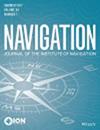城市峡谷中自主系统的三维视觉辅助GNSS实时运动定位
IF 2
3区 地球科学
Q1 ENGINEERING, AEROSPACE
引用次数: 1
摘要
提出了一种三维视觉辅助的全球卫星导航系统(GNSS)实时运动定位方法。为了减轻反射的非视距(NLOS)接收的影响,使用了一个带有深度神经网络的指向天空的相机来排除这些测量。然而,NLOS的排除导致了卫星几何形状的扭曲。为了填补这一空白,探索了低洼视觉地标与健康但高海拔卫星测量之间的互补,以改善几何约束。具体而言,通过滑动窗口优化,将惯性测量单元、前视相机捕获的视觉地标和健康GNSS测量紧密集成在一起,以估计GNSS- rtk浮子解决方案。然后解决了整数模糊和固定GNSS-RTK解。利用在香港城市峡谷收集的多个具有挑战性的数据集验证了所提出方法的有效性。本文章由计算机程序翻译,如有差异,请以英文原文为准。
3D Vision Aided GNSS Real-Time Kinematic Positioning for Autonomous Systems in Urban Canyons
In this paper, a three-dimensional vision-aided method is proposed to improve global navigation satellite system (GNSS) real-time kinematic (RTK) positioning. To mitigate the impact of reflected non-line-of-sight (NLOS) reception, a sky-pointing camera with a deep neural network was employed to exclude these measurements. However, NLOS exclusion results in distorted satellite geometry. To fill this gap, complementarity between the low-lying visual landmarks and the healthy but high-elevation satellite measurements was explored to improve the geometric constraints. Specifically, inertial measurement units, visual landmarks captured by a forward-looking camera, and healthy GNSS measurements were tightly integrated via sliding window optimization to estimate the GNSS-RTK float solution. The integer ambiguities and the fixed GNSS-RTK solution were then resolved. The effectiveness of the proposed method was verified using several challenging data sets collected in urban canyons in Hong Kong.
求助全文
通过发布文献求助,成功后即可免费获取论文全文。
去求助
来源期刊

Navigation-Journal of the Institute of Navigation
ENGINEERING, AEROSPACE-REMOTE SENSING
CiteScore
5.60
自引率
13.60%
发文量
31
期刊介绍:
NAVIGATION is a quarterly journal published by The Institute of Navigation. The journal publishes original, peer-reviewed articles on all areas related to the science, engineering and art of Positioning, Navigation and Timing (PNT) covering land (including indoor use), sea, air and space applications. PNT technologies of interest encompass navigation satellite systems (both global and regional), inertial navigation, electro-optical systems including LiDAR and imaging sensors, and radio-frequency ranging and timing systems, including those using signals of opportunity from communication systems and other non-traditional PNT sources. Articles about PNT algorithms and methods, such as for error characterization and mitigation, integrity analysis, PNT signal processing and multi-sensor integration, are welcome. The journal also accepts articles on non-traditional applications of PNT systems, including remote sensing of the Earth’s surface or atmosphere, as well as selected historical and survey articles.
 求助内容:
求助内容: 应助结果提醒方式:
应助结果提醒方式:


